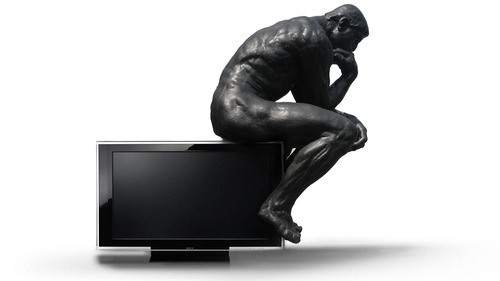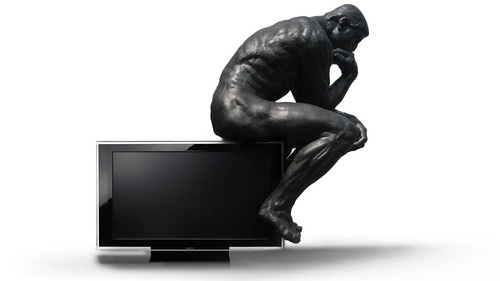
If there’s one thing that actually sorta makes sense to buy on Black Friday, it’s an HDTV—many are crazy discounted. But picking out an HDTV can be a big ball of suck. That’s where this guide comes in.
The 3DTV cheat
Want to buy a set knowing that it’ll have excellent performance without having to do a ton of poking and prodding? Buy a 3DTV. The thing about 3DTVs, says HD Guru’s Gary Merson is that in order to do 3D competently, they “have to do certain things really really well.” 3D sets are, generally speaking, the best performing sets in the product line. So even if you never intend to watch a single piece of 3D content, it’s worth considering a 3DTV.
Because the set’s delivering different images for the left eye and the right eye (here’s a refresher on how 3D works) it has to be able to switch the image it’s displaying “very completely and very fast,” says Gary. The end result is a TV with better processing power and better performance.
The main issue to look out for in 3DTVs is cross talk. Basically, cross talk is leakage—when the image for left eye shows up in the right eye, or vice versa, and you see ghost images. Depending on how much cross talk there is, you might even see two distinct images. And when it comes to no crosstalk, plasma sets beat the LCD competition. In fact, when it comes to 3D performance, plasma wins overall.
Plasma vs. LCD
For the money, plasma tends to beat LCD from a pure picture standpoint. Blacks are usually better, contrast is better, motion resolution is better, while the older issues like burn-in aren’t really problems like they used to be. The flipside of plasma sets are that they’re more power hungry, and they’re not as bright.
LCD sets, on the other hand, are brighter (watching them soaps at lunch again, eh?) thinner (design snob) less power hungry (hippie) and straight out cheaper (cheapskate). If you’re going for a set that’s under 42 inches, LCD is probably where you wanna go. The best kind of LCD TVs are LED backlit models (explained in-depth here) that typically deliver better color, better blacks and better contrast, though they’re pricey than the average LCD.
Do you really need 1080p?
The dirty secret about 1080p is that you don’t need it if you’re TV’s not big enough and you’re sitting too far back to see it. If a set’s under 40 inches, you don’t need 1080p—unless you’re going to be wiping snot streaks off the glass. The Lechner distance, named for this guy, is the optimal viewing distance at which your eye can fully process all the detail offered by an HDTV’s resolution. It scales, based on how big your TV is. (In English, it’s how far away you should sit from an HDTV.) An example: The average viewing distance in an American home is 9 feet from the set. In order to fully see all of the details 1080p offers at that distance, you’d need a 70-inch set. So if you’re sitting more than six feet away from your TV—or just buying a smaller set—considering saving some cash by going 720p. You literally won’t be able to tell the difference.
A few things to look for
Here are a few of the basic qualities to look for in sets that you can spot check—though be warned, most TVs on the showfloors at Best Buy or Home Theater Emporium aren’t going to be optimally tuned. But if salesmen wanna make the sale, they should let you mess around with the settings.
• Contrast ratio While the printed contrast ratio is a bullshit spec of the highest order, you can definitely see it on the set. Just look at the blacks. Today’s sets are plenty bright, so don’t worry about white. Load up a dark scene, cup your hands around a section of the screen and evaluate it. Is it glowing? Or is it inky? The darker the better. How smooth is the transition between light and dark areas?
• Viewing angle If you buy a bigass new TV, you want everybody to enjoy it right? That’s why viewing angle matters. To check it, just stand in the center of the TV and move to the right or left, noting if the colors start to get funky or desaturated. You want the widest viewing possible, so that the picture looks dandy no matter how off-center your viewing angle is. This is a bigger issue with LCDs than plasmas.
• Static and motion resolution Getting a little nerdier here, ’cause serious dorks evaluate this stuff with test signals, but ultimately, this is all about details. To check static resolution, try to count the number of hairs on somebody’s head in a closeup, or a player’s name on a jersey in a sports game. What about in motion? Are a running player’s legs just a blur? How well are details preserved when there’s a lot of movement going on.
That should more or less get you through Black Friday, especially if you arm yourself with a handful of reviews and narrow down the sets you’re looking at before you walk in the store.
Send an email to matt buchanan, the author of this post, at matt@gizmodo.com.


Good information.